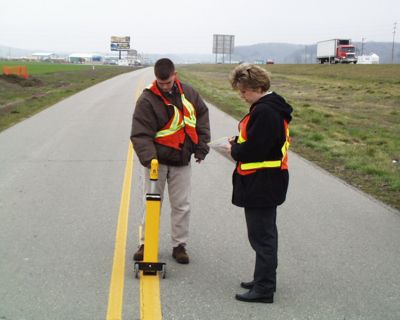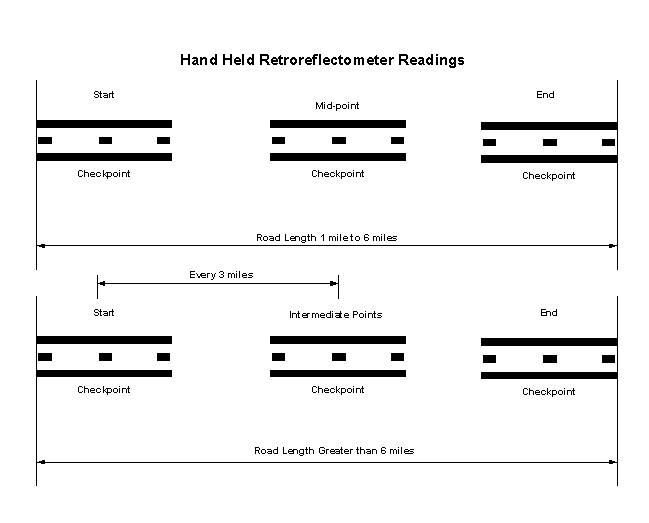Difference between revisions of "620.13 Measurement of Retroreflectivity by Handheld Retroreflectometers"
(Per Traffic and CM, revision to bring policy into substantial compliance with the 2009 MUTCD.) |
m (Updated website link (for increased security)) |
||
| (5 intermediate revisions by the same user not shown) | |||
| Line 1: | Line 1: | ||
[[image:620 Retroreflectivity reading.jpg|right|400 px]] | [[image:620 Retroreflectivity reading.jpg|right|400 px]] | ||
| − | The following guidelines are based on MoDOT Test Method | + | The following guidelines are based on MoDOT Test Method TM80 and ASTM D7585-10. |
These guidelines are to be used by MoDOT forces when determining the quality and remaining life of MoDOT pavement markings, both existing and newly applied. | These guidelines are to be used by MoDOT forces when determining the quality and remaining life of MoDOT pavement markings, both existing and newly applied. | ||
| Line 22: | Line 22: | ||
==620.13.3 Procedure== | ==620.13.3 Procedure== | ||
| − | '''620.13.3.1''' For new pavement markings, | + | '''620.13.3.1''' For new pavement markings, measurement of retroreflectivity should be delayed in accordance with [https://epg.modot.org/index.php/620.12_Construction_Inspection_for_Sec_620#620.12.2.3_Inspection_.28Sec_620.2.3.29 EPG 620.12.2.3]. |
'''620.13.3.2''' For existing pavement markings, measurements may be taken any time the pavement markings are clean and dry. After snow events, measurements shall not be taken until there has been a rain event that washes away all salt residue. | '''620.13.3.2''' For existing pavement markings, measurements may be taken any time the pavement markings are clean and dry. After snow events, measurements shall not be taken until there has been a rain event that washes away all salt residue. | ||
| Line 54: | Line 54: | ||
====620.13.4.2.3 One Mile < Road Length < Six Miles==== | ====620.13.4.2.3 One Mile < Road Length < Six Miles==== | ||
| − | Checkpoint areas shall be taken at the start, midpoint and end zones of roads greater than one mile long. Two measurements shall be taken on each of 10 consecutive intermittent pavement markings for a total sample size of 20 measurements in each checkpoint. The random measurement on | + | Checkpoint areas shall be taken at the start, midpoint and end zones of roads greater than one mile long. Two measurements shall be taken on each of 10 consecutive intermittent pavement markings for a total sample size of 20 measurements in each checkpoint. The random measurement on an intermittent marking shall be separated by at least 3 feet. |
====620.13.4.2.4 Road Length > Six Miles==== | ====620.13.4.2.4 Road Length > Six Miles==== | ||
| Line 68: | Line 68: | ||
{| border="1" class="wikitable" style="margin: 1em auto 1em auto" | {| border="1" class="wikitable" style="margin: 1em auto 1em auto" | ||
|- | |- | ||
| − | ! Colspan="3" style="background:#BEBEBE"|'''Pavement Marking Acceptance Table''' | + | ! Colspan="3" style="background:#BEBEBE"|'''Pavement Marking Acceptance Table, mcd/m<sup>2</sup>/lux''' |
|- | |- | ||
| − | ! !! style="background:#BEBEBE"| | + | ! !! style="background:#BEBEBE" width="90"| White !! style="background:#BEBEBE" width="90"|Yellow |
|- | |- | ||
| − | | New Markings || | + | |width="500"| New Pavement Markings || align="center"| 300 || align="center"|225 |
|- | |- | ||
| − | | Existing Markings || | + | | Existing Pavement Markings Expected to Last Through Winter (measured in the fall)|| align="center"|200 || align="center"|175 |
|- | |- | ||
| − | | | + | | Pavement Marking Failure Point || align="center"|150 || align="center"|125 |
|} | |} | ||
Latest revision as of 11:44, 22 October 2021
The following guidelines are based on MoDOT Test Method TM80 and ASTM D7585-10.
These guidelines are to be used by MoDOT forces when determining the quality and remaining life of MoDOT pavement markings, both existing and newly applied.
Contents
620.13.1 Scope
This method describes the procedure for retroreflectivity inspections of pavement markings using a handheld retroreflectometer.
620.13.1.1 Definitions
30-meter geometry. The geometry of the instrument measurement, based on a viewing distance of 30 m from an arbitrary passenger vehicle with an eye height of 1.2 m and a single headlight mounting height of 0.65 m in the same vertical plane and a pavement stripe directly ahead of the headlight.
Checkpoint Area. The marking area to be evaluated within each zone of measurement.
Sample Size. The number of measurements within a checkpoint area.
Retroreflectivity. The measure of the retroreflective quality of the pavement markings. The unit of measure is expressed as millicandela per meter squared per lux or mcd/m2/lux.
620.13.2 Equipment
The apparatus shall consist of a handheld 30-meter geometry retroreflectometer, such as the Mirolux 30 retroreflectometer or ART Stripemaster retroreflectometer.
620.13.3 Procedure
620.13.3.1 For new pavement markings, measurement of retroreflectivity should be delayed in accordance with EPG 620.12.2.3.
620.13.3.2 For existing pavement markings, measurements may be taken any time the pavement markings are clean and dry. After snow events, measurements shall not be taken until there has been a rain event that washes away all salt residue.
620.13.3.3 Take all measurements in the sampling areas in the direction of traffic flow, except on the centerline of two-lane roads, then take the required number of measurements in each direction. Measure both single and double lines, and apply the acceptance criteria for each line in both directions.
620.13.3.4 Because handheld retroreflectometers normally shoot a beam of light approximately 6 in. to 12 in. in front of the machine’s lens, locate the unit approximately 6 in. to 12 in. from the pavement marking to be read.
620.13.3.5 When selecting a checkpoint for existing markings, care should be taken to find a section of pavement marking that is typical for the section of road. Measurements should not be taken within close proximity of side roads, entrances or other areas where extreme wear of the pavement markings may occur.
620.13.4 Sampling
620.13.4.1 Solid Longitudinal Lines
620.13.4.1.1 Road Lengths < 1000 Ft.
Randomly select one 300 ft. section of pavement marking for testing. Take measurements approximately every 15 ft. along the pavement marking line. Take a total sample size of 20 measurements.
620.13.4.1.2 1000 Ft. < Road Lengths < One Mile
Break the roadway to be tested down into segments of equivalent lengths. Keep the segment lengths as close as possible to 1000 ft., but the segments may be as small as 500 ft., as would be the case when the total roadway length to be tested is only 1001 ft. long. Within each segment, randomly select one 300 ft. section of pavement marking for testing. Take measurements within the 300 ft. sections of roadway approximately every 15 ft. along the pavement marking line. Take a total sample size of 20 measurements for each section.
620.13.4.1.3 One Mile < Road Length < Six Miles
Checkpoint areas shall be taken at the start, midpoint and end zones of roads greater than one mile long. Take measurements within each checkpoint with a sample size of 20 measurements taken every 15 ft. within the check point.
620.13.4.1.4 Road Length > Six Miles
Checkpoint areas shall be located at the start and end of the road and at intervals of every 3 mi. within the length of road. Take measurements within each checkpoint with a sample size of 20 measurements taken every 15 ft. within the check point.
620.13.4.2 Intermittent Longitudinal Lines
620.13.4.2.1 Road Lengths < 1000 Ft.
Take two measurements on 10 random intermittent pavement markings, giving a total sample size of 20 measurements. Take measurements on each intermittent pavement marking at minimum 3 ft. apart.
620.13.4.2.2 1000 Ft. < Road Lengths < One Mile
Break the roadway to be tested down into segments of equivalent lengths. Keep the segment lengths as close as possible to 1000 ft., but the segments may be as small as 500 ft., as would be the case when the total roadway length to be tested is only 1001 ft. long. Within each segment, randomly select one 300 ft. section of pavement marking for testing. Within each 300 ft. section, take two measurements on 10 random intermittent pavement markings, giving a total sample size of 20 measurements for each section. Take measurements on each intermittent pavement marking at minimum 3 ft. apart.
620.13.4.2.3 One Mile < Road Length < Six Miles
Checkpoint areas shall be taken at the start, midpoint and end zones of roads greater than one mile long. Two measurements shall be taken on each of 10 consecutive intermittent pavement markings for a total sample size of 20 measurements in each checkpoint. The random measurement on an intermittent marking shall be separated by at least 3 feet.
620.13.4.2.4 Road Length > Six Miles
Checkpoint areas shall be located at the start and end of the road and at intervals of every 3 mi. within the length of road. Within each checkpoint two measurements shall be taken on each of 10 consecutive intermittent pavement markings for a total sample size of 20 measurements.
620.13.5 Acceptance
- At each checkpoint, the average of the 20 sample readings shall be calculated. This is the average sample reading.
- The number of average sample size readings below the figures in the following table will be used for acceptance or rejection.
- For cases in which 20 sample size measurements are taken for a segment of roadway, if 17 or more of the sample readings are above the minimum value required, accept that segment of pavement marking. If four or more readings within a segment are below the minimum value required, the markings are rejected.
| Pavement Marking Acceptance Table, mcd/m2/lux | ||
|---|---|---|
| White | Yellow | |
| New Pavement Markings | 300 | 225 |
| Existing Pavement Markings Expected to Last Through Winter (measured in the fall) | 200 | 175 |
| Pavement Marking Failure Point | 150 | 125 |

